On this edition of Riverwalk Jazz, “Swing’s the thing” as we celebrate the Big Band Era and the music of Count Basie, Benny Goodman, the Dorsey Brothers, Duke Ellington, Glenn Miller and more. Guests include Lionel Hampton, a key creative force within the Benny Goodman Orchestra and the very first vibraphone soloist in jazz. Also with us are two outstanding artists who helped shape the sound of the Count Basie Band—trumpeter Clark Terry and piano man Jay McShann.
Swinging away night after night at the Reno Club in Kansas City in the early 1930s, Count Basie pioneered a riff-based, blues-drenched style that would evolve into ‘Swing’ or the Big Band sound. Late night live radio broadcasts from the club played an important role in Basie’s success. Legend has it that one night when the band was on the air live, the radio announcer caught Basie off guard when he asked, “What are you going to play next, Count?” It was past midnight and Basie, who was casual about naming tunes and writing down set lists, was taken aback for a second. His eyes fell on the clock, and he said—“One O’clock Jump,“ making up the title of a tune that would help define the era and turn out to be Basie’s first hit recording in 1937. Our version features the great Kansas City pianist and vocalist Jay McShann.
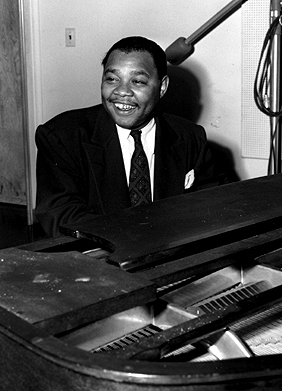
Kansas City blues legend, Jay McShann. Photo courtesy of Clemson University.
You might be surprised by the similarities between the early 1920s jazz bands of King Oliver and Louis Armstrong and the sounds of the popular big bands of the 1930s. As an example, this week bass saxophonist Vince Giordano and hot violinist Andy Stein join The Jim Cullum Jazz Band for “San,“ a hit for the Paul Whiteman Orchestra. The earliest recordings of this tune pre-date the heyday of the Swing Era by a decade, but you can hear the roots of the big band sound in the drive and the highly complex musical arrangement.
Bob Crosby, the kid brother of crooning superstar Bing Crosby, led what might have been the most unusual big band of the era. It was founded collectively by a group of high-powered musicians dedicated to preserving the spirited, free-wheeling sound of early jazz. The early Crosby band was a thirteen-piece ensemble. Unlike most big bands, every member was a virtuoso soloist with Yank Lawson on trumpet, Matty Matlock and Eddie Miller on reeds, Nappy Lamare on guitar, Ray Bauduc on drums and a tall, handsome bass player named Bob Haggart. Haggart has been described as the “undiscovered Gershwin of the Thirties.” He was responsible for most of the Crosby Band’s outstanding musical arrangements, and Haggart composed highly successful tunes like “My Inspiration,” “Big Noise from Winnetka and a salute to his home town of Douglastown, Long Island, called “Dogtown Blues.“ The rendition here was recorded live at The Landing in San Antonio, and features Bob Haggart on bass with another Crosby Band alumnus, trumpet star Yank Lawson.
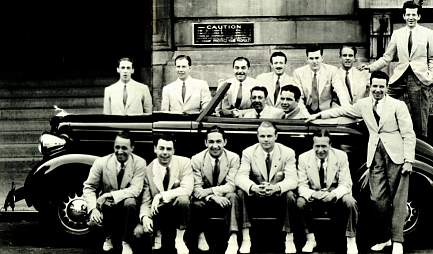
Bob Crosby and the Bob Cats, 1937. Photo by Nat Shapiro and George Hoefer.
In the late 1930s jazz became the mainstream popular music for the first time. In 1917 the Original Dixieland Jazz Band had launched a short fad with their recording of “Livery Stable Blues.” But the early 1930s ushered in the decades long Swing Era, a time when teenagers listened to jazz, loved it, bought records and fueled a huge industry galvanized by ‘Swing fever.’
Jim Cullum says, “Suddenly jazz was in the mainstream, and musicians who had been struggling to make it found themselves in demand with all the big bands in business. Now, instead of bands having only one trumpeter as in the early New Orleans-style model, there was a whole section of trumpets as well as reeds and trombones. Soon many musicians working in popular big bands wanted to ‘break out of jail’ and play in small ensembles where they could be showcased and wouldn’t be restricted by formal written arrangements. Musicians who have experienced playing in small bands that center on collective improvisation seem to always be drawn to this kind of playing—and even yearn for it. So, Benny Goodman, the Crosby Band and others developed the idea of the ‘band within a band.’ They broke the big band sound into septets, sextets, quartets and trios. This gave concert audiences variety, and it gave the musicians an added creative outlet.”
Benny Goodman composed “Rachel's Dream“ (titled for his baby daughter) for his sextet in which he played clarinet with Red Norvo on vibes. Our version features clarinetist Allan Vaché and vibist John Cocuzzi.
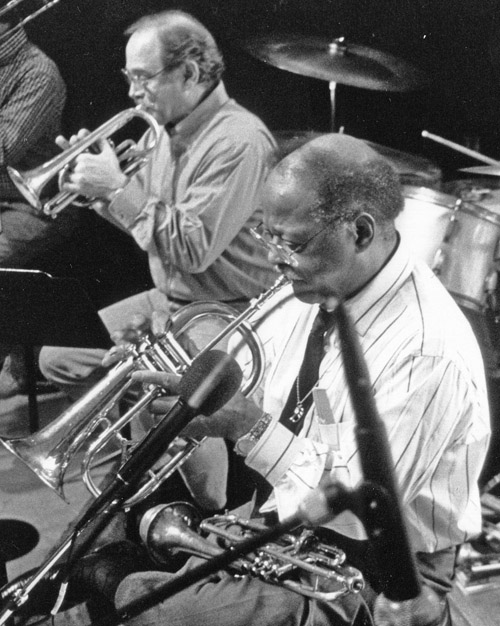
Clark Terry joins Jim and the band. Photo courtesy of Riverwalk Jazz.
Trumpet master Clark Terry is a veteran of both the Count Basie and Duke Ellington bands. Here he also handles the vocal on “It Don't Mean A Thing (if It Ain't Got That Swing),“ a hit for Ellington and Ivey Anderson in 1932. Duke Ellington was ahead of his time in using “swing” as a concept in this song title. It wasn’t until 1935 that “Swing fever” really started to catch on. The impetus was Benny Goodman’s Saturday night radio series, Let’s Dance. Though musicians had been using “swing” for years to describe hot jazz, in the mid-30s it became a household word.
Goodman was a great popularizer of Swing music, but for many aficionados Count Basie’s rhythm section epitomized ‘swing.’ Once Basie was asked for a definition of ‘swing,’ and he put it very simply: “Swing is music you can pat your foot by.” Clark Terry plays a Basie Band number written by Neil Hefti, called “Lil' Darlin.'“ It’s an example of a polished big band tune played at a slower tempo.
Lionel Hampton says he learned to play his first instrument, the drums, from a Dominican nun while attending The Holy Rosary Academy in Kenosha, Wisconsin. Some years later in 1936, Lionel got a personal invitation to join Benny Goodman’s quartet, where he shared the stage with a dynamic group of musicians, including bandleader Goodman on clarinet, Gene Krupa on drums and Teddy Wilson on piano. Hampton’s exciting vibes playing became an important element of the Goodman Quartet’s powerful, precise sound. In 1939 Hampton recorded “Flyin' Home“ with the Goodman Sextet and it became a huge hit and Hampton’s theme song for many years. During the war years, Glenn Miller and the Army Air Force Band he led adopted “Flyin' Home“ as their radio theme. The Miller Band mega-hit “In The Mood“ and “Flyin' Home“ were stitched together in Hamp’s big band library as a medley arrangement, which Hamp performs with The Jim Cullum Jazz Band on this week’s show.
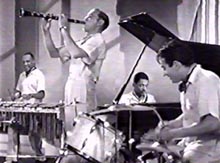
The Benny Goodman Quartet. Photo courtesy of lastfm.
Also on this broadcast, another Miller Band hit from 1941, “String of Pearls.“ Miller’s original recording featured a famous cornet solo by Bobby Hackett, recalled in our interpretation heard here by the Australian cornet master Bob Barnard.
There were many outstanding bands in the Swing Era. Glen Gray and the Casa Loma Orchestra was a trend-setting band early on. Jimmie Lunceford, Jack Teagarden, Harry James, Artie Shaw and Bunny Berigan all toured and recorded with their own bands. The most successful big bands had a combination of three elements: great arrangements, excellent soloists and a clearly definable style. Trombonist Tommy Dorsey, who led one of the most successful and longest-running big bands, aggressively went after star soloists and featured instrumentalists like Bud Freeman and Max Kaminsky. He sought out singers and signed rising stars Frank Sinatra and Jo Stafford. His arranger was the talented Sy Oliver.
Dorsey’s hits included his famous theme song “I’m Getting Sentimental Over You” and “The Song of India.” For our show, trombonists Dan Barrett and Mike Pittsley pay tribute to Dorsey with a virtuoso showcase he wrote for himself in 1947, “Trombonology.“
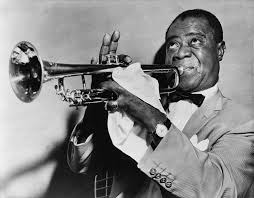
Louis Armstrong. Photo courtesy of the Library of Congress.
Jim Cullum says, “Many people see a huge difference between the 1930s Swing bands and groups from the 1920s like King Oliver and Jelly Roll Morton. On the surface these would seem to be extremely different forms, but to me they are very, very similar. The core essentials—the rhythm and the approach to the beat is the same. It’s what musicians call the ‘time feel.’ The bands of the Thirties took the earlier form and organized the horns into sections. That’s basically the only difference—the solos are the same, the rhythm is the same, and the feel of the ensemble is much the same, too. Louis Armstrong’s early playing set the style for these bands. All the riffs, licks, accents, and the excitement of Louis’ playing in the smaller bands of the Twenties is so profound that musicians couldn’t help being influenced by it in the Thirties. You could say that the Swing Era was Louis’ style organized for a thirteen-piece hot band. In the 1930s almost all the jazz musicians were listening hard to Louis, and they were listening to his disciples like Bunny Berigan and Harry James. Jack Teagarden, Goodman, the Basie guys all got their feel for the music and their approach to it from Louis. This gave the Swing bands a ‘one-mind’ approach. The goal was, ‘how hot can we make it? Can the whole band swing like Louis did with the Hot 5?’ That was the goal, and musicians were consciously, or unconsciously, copying Louis. This is the main factor that makes the early jazz of the 1920s at the core of the big bands, and basically makes this all one music.”
Jim Cullum and his Band illustrate this point with their 7-piece rendition of the “anthem of Swing,” “Sing, Sing, Sing,“ made famous by Benny Goodman’s historic 1938 Carnegie Hall concert.
Photo credit for homepage image: Poster for Count Basie and His Orchestra, 1939. Image courtesy allposters.co.uk
Text based on Riverwalk Jazz script by Margaret Moos Pick ©1998


